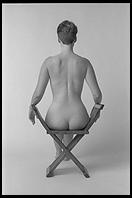
Nudes
by Philip Greenspun; revised January 2007
Site Home : Photography : Nudes
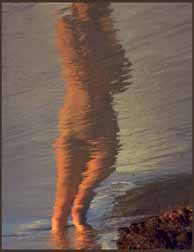
This is a composition that was hiding inside a larger image. I didn't notice the photo until I got the film back. What you see at right is about 1/5th of a 6x6 negative that contains the model, a beach, some rocks, and a whole bunch of other stuff. By itself, the picture is a loser. Cropped heavily, one could call it art. That's one of the nice things about medium format.
Rollei 6008, 250mm lens, tripod, Kodak VHC color negative film.
Here's an excerpt from "Career Guide for Engineers and Scientists" ...
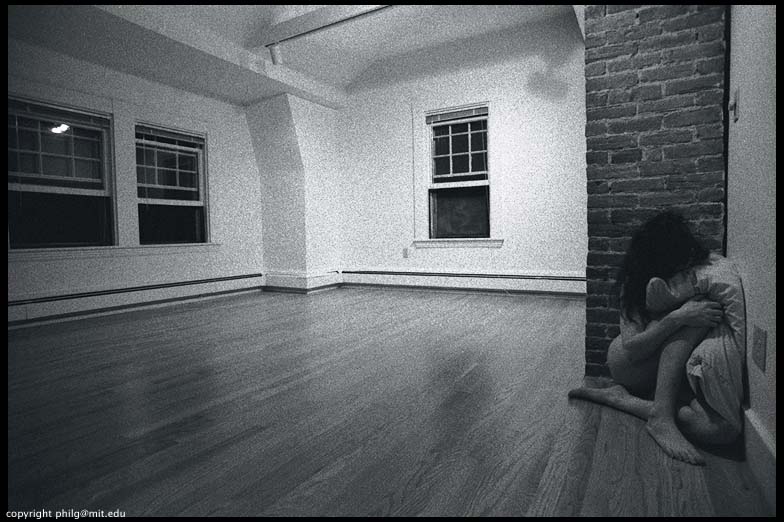 |
Rachel, PhD Biology UCLA 1992, enjoys the wealth of material comforts that she has accumulated during 10 years of hard work in science. (click on the photo for a 500x750 JPEG; click here for a 1000x1500 screen-filling image) |
1100 square feet of bare hardwood floors called out: "You will never have this opportunity again. Tomorrow you are going to move all of your worldly goods into this new condo. You'd better grab your Canon EOS-5, 20-35/2.8L lens, and TMAX 3200." The model and room both have to be bare to show the bleak poverty of the unemployed PhD.
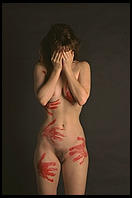 |
TIME Magazine ran a cover story on "date rape" on June 3, 1991. This is an image that could have been used. |
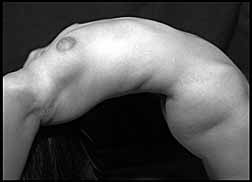
Here's a photo from junior year at MIT, 1981. The background is a dark brown blanket. Illumination is from a dormitory overhead light. The camera was a tripod-mounted Yashica twin lens reflex (6x6), valued at approximately $100.
In 1993, I tried to duplicate the picture with higher-tech equipment, starting with a $5,000 Rollei 6008, elaborate studio strobe system with softbox, and motorized seamless paper background. Even the model was higher tech (taller, thinner). The results? Pathetic. The room light was too bright to adequately judge the outcome with the strobes' modeling lights. Consequently, the image was much too high in contrast.
Sometimes a brain is more important than a fancy camera.
Most nudes are static, heir first to the tradition of painting and then to the limitations of early cameras. But with $30,000 of studio strobes, why not show the body in motion? Richard Avedon keeps his models constantly in motion so that he never gets a frozen deer-in-the-headlights look. To ensure that the light on each model stays constant as he or she moves, Avedon has assistants follow the models around with lights at the end of booms.
(To create some images like these, start by reading this primer on studio photography.)
It is tough to find anything actualy wrong with the picture on the left, a standard studio photo made with a seamless background, medium format camera, and softbox. However, the right hand "environmental nude" has more character.
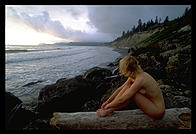 |
A favorite image from Travels with Samantha. Fuji Velvia film was not noted for its subtlety with flesh tones, and therefore you might prefer the hand-colored in PhotoShop. (If you want to know how to do this easily, check out our hand coloring tutorial.) |
People get uncomfortable when staring at other people's genitalia, so it is generally best either to get rid of the genitalia or the face.
Of course, Mapplethorpe made almost a whole career out of violating this rule so if you want lots of money and fame, you should probably ignore this rule.
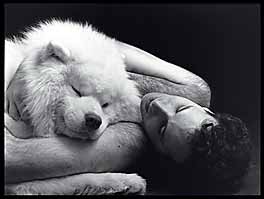
me and George (please do not send email asking which one is the dog)
George was the inspiration for Travels with Samantha, which begins with his end.
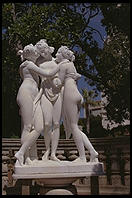
"I checked a few different sources for info on the 3 graces, and all I could find is that they are continually anointing mortals, making them appear extremely beautiful and immortal to their pursuers. But I couldn't find why there are three of them or why they are called "graces". I think there is some conflation with the Erinyes, who hounded Orestes after he murdered his mom, but then he sacrificed to them and they became Eumenides, and at the same time he sacrificed to the Graces. They are benevolent goddesses - that much I can say for certain."
-- a classics nerd friend (Ph.D. from Princeton)
At right is a copy of a classical statue at the Hearst Castle in San Simeon. Below, in declining order of fidelity to the classical traditional, are interpretations of the theme.
That's the motto of the MIT men's water polo team. We did a fund-raising calendar (September 1998-December 1999) of these beefcake-y guys.
Note: Another project with Adriane: The Game.
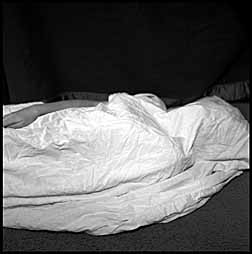
The line between art and pornography is fairly thin, but it is there. At right is a photo taken for an undergraduate photography course at MIT. A couple of professors loved it. They thought it was art, expression, new, whatever. They hated the arch nude above and preferred this one. So I guess this is art...

Black and white images made with infrared light tend to erase to erase skin blemishes and impart a lustrous luminous quality to human skin. In the old days, folks would read Laurie White's Infrared Photography Handbook and then trying out a few rolls of B&W IR film (example at right). It was never easy to take infrared photos casually because you'd have to focus in two steps: turn the focus ring until the image appeared sharp in the viewfinder and then take move your eye to the top of the camera and turn the focus ring a bit so that the infrared focus mark lined up to where the focus ring had been. Different wavelengths of light require different focus positions for the lens. All of the visible wavelengths are close enough in size that you can pick a single focus position and not have too much distortion from this effect, which is why photographers don't typically think about it.
What about infrared photography with a digital camera? It should be very easy indeed, since the CMOS and CCD sensors at the heart of a digital camera are inherently sensitive to near-infrared light. Unfortunately, the manufacturers put a filter over the sensor to screen this out and limit image formation to visible light. The easiest way to deal with this challenge is to contact the folks at www.maxmax.com. Mail them your camera and some cash; they rip out the filter, tweak the camera so that it will autofocus properly in infrared, and return it to you after a day or two. Life is much easier than in the old film days because (1) you don't have to tweak the focus manually after making the image sharp for visible light, and (2) you get an instant preview.
Every now and then someone sends email asking "How do you get women to take their clothes off?" The answer is that the world divides into two classes of people: those who like to be photographed and those who don't. Those who like to be photographed think they have beautiful bodies. Naturally, if they look good in a picture clothed, they'd look better without all those ugly clothes standing between their beautiful body and the camera. If you therefore find some folks who have survived the constant assault on their self esteem by advertisers, the challenge will be to get them to keep their clothes on. It also helps to have a portfolio of high quality work.
How to develop that portfolio? Here's a 12-step program:
If you're using digital equipment, your photos will be secure on your camera's memory card and on your personal computer's hard drive. Thus, any nude images will be viewable only by you or, if your system administration skills are sub-professional, by Bill Gates, most American 13-year-olds, half of Russia, and the U.S. Government.
If you're using film and/or using commercial labs for printing, you risk criticism. Big photo labs generally will develop tasteful nudes with no questions asked. The customer service department at Kodak's stated their policy as "if there is only one person in the picture, we're definitely not going to have a problem with it." There are laws in some states requiring labs to report photographers who bring in images of naked children. More than a few serious photographers have had unpleasant, expensive, and prolonged dealings with government authority stemming from what you'd have thought were easy calls (e.g., a San Franciscan who took his 8x10 view camera to a nudist colony and photographed families with their consent).

Before investing a weekend, you might want to spend some time with the following books:
If you are looking for inspiration rather than tutorial, leaf through the 425 smallish pages of The Body (William Ewing; Chronicle Books). This covers over 100 years of nude photography, right up to the repulsively hairy body of John Coplans, whose self-portraits definitely constitute one of the nastiest things one can do with a 4x5 view camera (actually his assistant takes the pictures; he just sells them for $5000 a whack).
If you're looking for something more in the coffee table line, Graphis Nudes gives you 200 big well-printed pages of contemporary nudes. Not as huge and only 116 pages long, the Aperture monograph of Edward Weston's nudes can be awe-inspiring. Do we really have something to say that he didn't say back in 1930? And if so, is it aesthetic?